Mealybugs and Red Spider mites top the list of garden enemies, and also for the indoor plants - house and greenhouse. Some of the fruit enemies are in this A - S listing - especially for Strawberries and Raspberries.
In the ornamental garden, the Rhododendrons find a few enemies on this page, or should we say that the enemies find the Rhododendrons?
Study the list, and do what you can by way of prevention of these garden pests.
More than anything, good cultivation, cleanliness and awareness are the best preventative measures. If this is unsuccessful, then correct identification before applying chemical sprays is always an essential element in pest control in the garden.
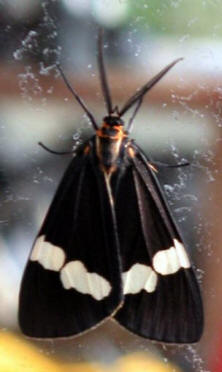
The caterpillar of the magpie moth are quite at home eating either gooseberries or currant - black or red.
The caterpillar is easy to recognise because of its bright colouring, and also the way it arches its back as it crawls along the leaf stems. This characteristic of humping along is called looping, and there are several caterpillars referred to as looping caterpillars.
The larvae of the Magpie moth are not considered to be too much of a nuisance - other than a little defoliating. However, they should be picked off the Gooseberry, blackcurrant or redcurrant as soon as seen.
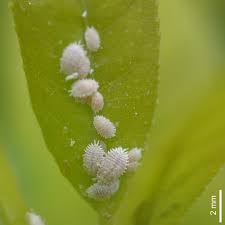
Mealybugs are small fluffy or waxy looking insects - aphids - that can be difficult to control or kill.
Mealybugs mainly attack only plants grown indoors or in the greenhouse. They are particularly troublesome on Cactus plants - Cacti - and also with some of the Orchids. However, they can also be a pest outdoors.
Mealybugs are members of the Aphid family, and as such obtain their food by sucking the sap out of plants.
The actual bug is a pinkish grey/green in colour, but you are more likely to find it by seeing it with its white furry coat on! This coat is made of waxy hairs, and grouped together as they often are, mealy bugs can look like small tufts of cotton wool. The mealy bug is up to 6mm long.
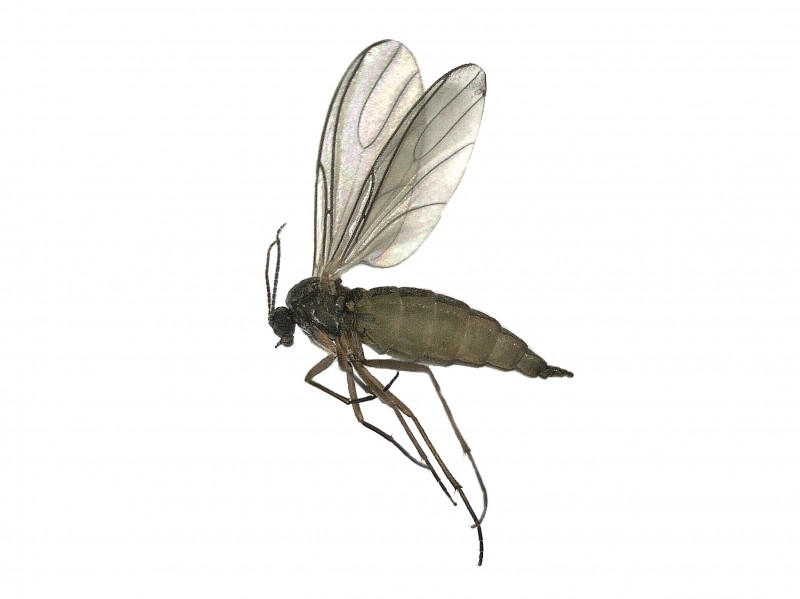
Sciarid Flies are small midge like flies or gnats on composts of houseplants - indoor plants - lay eggs in the compost and the small maggots that emerge are happy to live on the decaying matter of peat based composts, or even attack the small roots of the pot plant. The midges - flies - are often seen flying about near houseplants.
The small grey black fly is just an eighth of an inch long - 2 - 4mm - and is normally seen hopping about on the surface of the compost, or flying around the pot plant. Often referred to as midges.
The maggot feeds just below the surface of the compost, but can sometimes be seen on the surface.
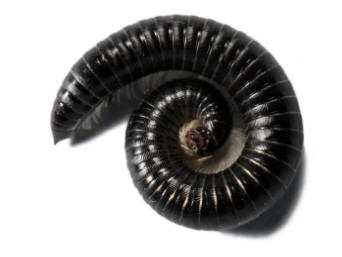
The Millipede is and underground feeder of roots, bulbs, corms and underground plant parts. it is a slow moving black or spotted grub that normally curls up if disturbed. It has many small hair-like legs which are carried below its body.
It is happy feeding and causing damage on roots of all plants, and also bulbs and tubers. Most writings will tell you that Millipedes mainly live on decaying organic matter such as dead roots and leaves.
They are prone to burrowing into potato tubers, various bulbs and also young plant roots. However, Millipedes should not be mistaken for wireworms. In the greenhouse they can be a troublesome pest, and if plants suddenly fail, then Millipedes damage must also be thought of as a possibility. Greenhouse infestation is rare – unless there is a lot of debris that will give them shelter. Keep the greenhouse tidy, and Millipedes should never be a problem.

Moles are one of the most frustrating of all garden and lawn pests! They are rarely seen, but can cause absolute mayhem. The damage they do to plants is minimal, but if you are unfortunate enough to have moles in your garden, they will cause you more angst than an infestation of aphids! The main problem being, that they are so difficult to get rid of, and you normally see the damage they do, before you realize that you have a mole or so!
Now then, whenever someone says 'I have a Mole !' I cant help thinking about this funny Jasper Carrott sketch from the 80's
For you youngsters here is your first chance to see it, for us oldies, you may appreciate watching it again.
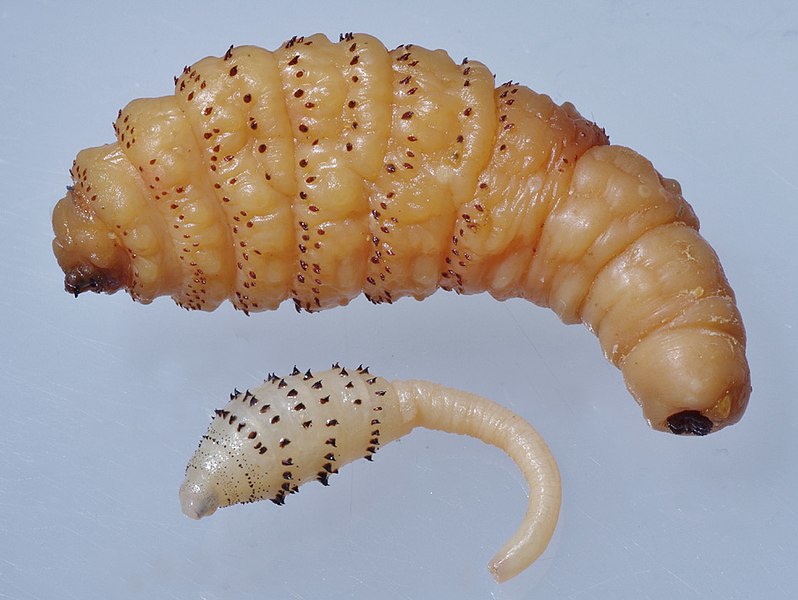
Narcissus fly attacks other bulbs as well as narcissus - daffodils.
They are also responsible to damage of the bulbs of Hyacinths, Irises and Snowdrops.
The Narcissus fly swoops just as the foliage is dying down on the bulbs - after flowering - and lays its eggs in the crown of the bulb. The eggs hatch and become the maggot - grub - of the fly and bore down into the bulb where they feed on the inside fleshy scales and emerging flower bud.
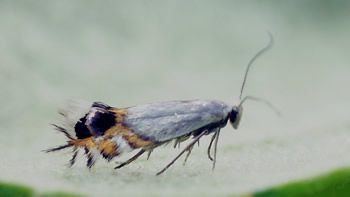
A serious pest of Pear, Apple and Sorbus trees - both in the USA and UK - Europe.
Pear leaf Blister Mite can either cause fruit spot damage, or spotting - blistering of the leaves - normally on the undersides. In the UK, is is more of a problem of Pear Trees grown against walls and fences.
The damage first appears on pear leaves with typical small green pimples which soon turn to red, and then brown.

Pear Midge is quite a serious pest of pears, and there is no effective chemical control of which we are aware. Any applied chemicals would gave to be applied when blossoms are open, therefore destroying beneficial insects at same time. In hot weather in particular, the pear midge will congregate in large numbers
The small pear fruitlets start to turn black soon after blossom drop, and then fall to the ground. If you open one of these pears, then you will find a small maggots of the Pear Midge - creamy coloured and just a few millimetre long
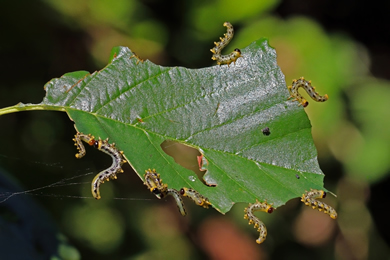
The first sign of the infestation of the Plum sawfly, is a small hole in the plum - surrounded by sticky substance on the surface surrounding the hole.
Inside the affected plum, you will find the maggot of the Plum Sawfly - around 1 cm long, creamy in colour.
Commercially, Calypso has been seen to give a degree of protection when sprayed at the end of flower cycle - ie as the petals of the Plum blossom fade and drop.

The Plum Moth is starting to be a big pest for gardeners in the UK. It has always been a pest in many US states and also throughout Europe, but it is only recently emerging as a serious pest in the UK. It is a known pest in Asian countries, so may well be an import into the country, where the (generally) milder climates are developing – allowing the Plum Moth – and other insect pests to live.
As the name suggests, the Plum Fruit Moth causes damage to plums, damsons and greengages. It has also been found in Apricots on the US, so presumably home grown Peaches might also be a target in the UK. In keeping with most fruit pests, it is mainly troublesome in the fruit itself – rarely damaging the foliage or flowers.

In this section, we distinguish between soil problems and root problems. It is not always easy to decide what causing the problem, for root pests and diseases live in the soil for most or all of their life. Soil problems are normally nutrient imbalance or physical aspects of the soil makeup, such as heavy clay soils.
The difference has to be properly recognised for there is little to be gained by treating a root pest or disease problem with fertiliser!
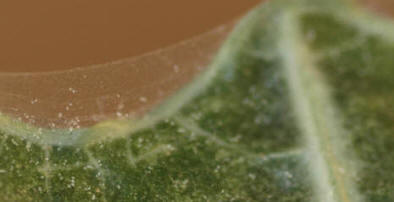
Troublesome pest of many plants - particularly indoors or in greenhouse. Information and advice how to prevent and treat red spider mites.
The first thing that is normally noticed about red spider mite, is the damage that it is either doing - or has done!.
Red spider mites are so small, that they can only just bee seen - if looking - by the human eye. However, the damage done by these pests soon becomes apparent. The name is a bit of an anomaly - red spider mites are normally green in summer months!
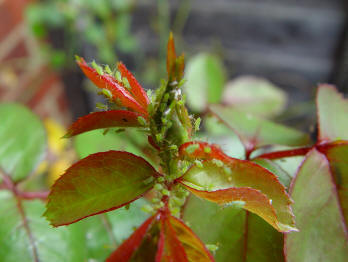
All roses are a target for the two main aphids - greenfly and Blackfly.
These aphids can soon take the strength out of your rose bushes if not checked in the initial stages.
The greenfly is by far the most common pest of roses, and as can be seen in the photo, they normally start feeding on the tender young shoots and buds.
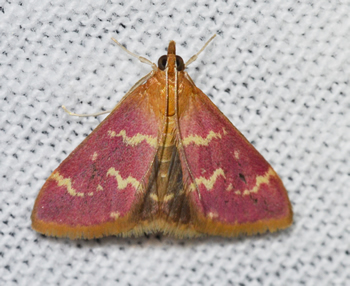
Raspberry Shoots that Die or look unhealthy, could be suffering from the maggot - caterpillar - of the raspberry Moth.
Inside the stem of the Raspberry cane - feeding on the pith, if you find a red maggot larva around 1cm long, then it is probably the larva of the Raspberry Moth. It lives overwinter in the soil, then emerges in March April to bore its way into the stem of the canes and then eats the lifeblood of the cane - the pith - and results in the Raspberry cane dying back.
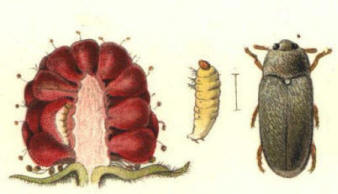
The raspberry beetle and its maggot - grub, is probably the most destructive annoying pest of raspberries, blackberries and loganberries. Many are not found until the ripe raspberries undergo the ritual 'drowning' in cold water before being prepared as puddings etc.
The adult beetles feed on the flowers, where they lay their eggs. The young maggots than bore into the young fruit where they feed until either picked or the fruit drops. The maggot then lives in the ground - overwinters and emerges as the adult beetle, ready to begin the life cycle again with either raspberries, blackberries or loganberries as hosts.
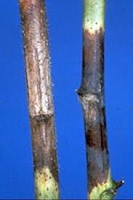
Raspberry Cane Blight is a fungal disease affecting both well managed and neglected raspberry stands alike.
The spores of the fungus -Leptosphaeria coniothyrium - normally enter the cane at damages points. The damage need not be extensive for entry to take place - slight bruising of the stem seems to allow entry to the Raspberry Cane blight. Pruning - essential in raspberry fruit production, is sometimes the entry point for the fungal spores.
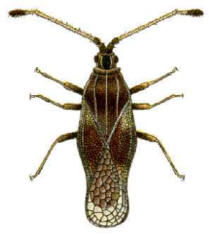
The Rhododendron and Azalea Bug. Rhododendron Lace Bug causes damage to leaves, causing them to roll downwards.
The leaves are normally mottled on the top surface, but seen to be brown on the underside. On the underside if the damaged leaf, you may find several of the Rhododendron Bugs.
The bug is normally no more than a few millimetres long with dark colourings. The lace pattern wings are a good camouflage and it may be difficult to see the bugs. The bugs and also their young - nymphs - have sharp mouth parts with which they pierce the leaf to suck the sap - causing the leaf damage and symptoms described above.
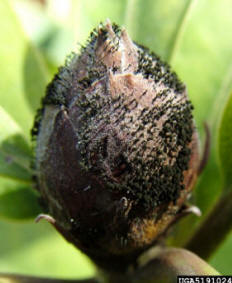
Rhododendron bud Blast is a fungal disease of Rhododendrons and Azaleas, affecting the tight dormant flower buds. The disease if more noticeable in the spring, when buds will be dark brown and normally covered in small black hair-like growths of the fungus disease. It causes brown buds to form on the plants of either Rhododendrons or Azaleas. The brown flower buds do not open.
The affected Rhododendron or Azalea buds will be firm to the touch, unlike those brown buds which are sometimes associated with either severe frost damage, or lack of water in important July-September growing months of the previous year.
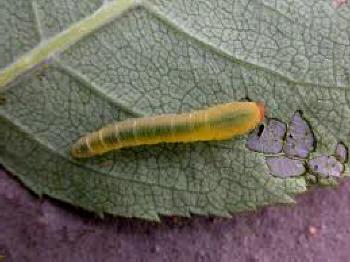
They are not true caterpillars – as close inspection will reveal. Rose Slugs or Slugworms will adequately describe them with their slimy shiny skin which looks like the common garden slug.
Rose Slugworms are the larvae of the Rose leaf Sawfly – which in spite of its name rarely does any damage to the rose leaves. It simply lays its eggs – sometimes three broods in a year – on the underside of rose leaves. The eggs then hatch out into the slug-like larvae which eat into the top surface of the rose leaf, leaving the veins and underside of the leaf looking like a partial skeleton. The damaged leaf eventually dies.

Leaf Rolling Sawfly damage is easy to see. The leaf rollers literally roll up the leaves - often on rose bushes - and lay their egg inside the cosy little nest they have formed. The egg hatches out into a grey green grub - caterpillar - that feeds on the sap from within its home.
The rolled up leaf normally shrivels and dies.
Damage starts in late spring, as leaves at the tips of new growth are drawn down to form a circular 'enclosure' for the eggs to be laid and resulting grubs to feed on the leaves and sap.

Problems with garden soils are normally the least visible – until they affect the growing plant. Soil problems in the garden can be associated with lawn problems (often) and general visible sickness symptoms on plants which are not otherwise associated with pests or diseases. Waterlogged soil is perhaps the most noticeable of soil problems.
There are many types of garden soil, and each of them have their own set of physical problems, such as light soils prone to drying out and heavy soils becoming waterlogged. Light and heavy are not the only soil types; there are many variations between
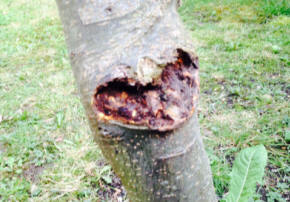
Problems on bark or inside plant stems can be caused by plant pests, plant diseases, malnutrition, physical aspects, frost damage, sun damage and many other things.
Plant stems are a good line of transport for garden pests that want to travel from leaf to leaf. Often the stem is simply used as a means of getting from point A to B. But there are a number of problems - generally associated with pests or diseases - that can cause problems directly to the plant stem. On the pest side, slugs are quite happy to chomp away at the more tender stems, whilst some fungal diseases cause problems with plant stems also. Blackleg fungus is one such disease which affects plant stems.

Scale insects feed on plants in the garden, greenhouse, or the living room! There are various types of scale insects and they are difficult to control in a single application of insecticide. It normally takes several treatments of suitable pesticide - insecticide.
Scale insects are normally quite easy to recognise, in that they are literally like small raised scales - usually brown - living along the leaf 'veins' either on the top of the leaf or its underside.
They can either be 'crusty' or soft scales. They are also to be found upon stems once the infestation has taken hold. They do not move too much, and you will not find any legs! (Just think in terms of a miniature tortoise minus legs or head.) They are typically up to 3 or 4 mm long (1/8th in). The young are much smaller and sometimes light sandy brown in colour.
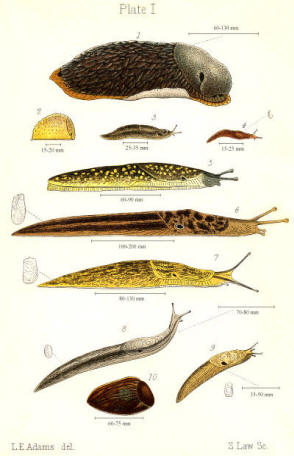
Slugs are probably responsible for most harm done to plant foliage in UK gardens. They are quite easily controlled, but there is a lot of controversy over the main means of control - Metaldehyde. We have no problems in suggesting this as a means of controlling slugs - see here.
There are many different types of slugs. They are all vegetarian, so partial to virtually any plant in your garden! Some slugs are happy to spend life above ground, chomping away at foliage and flowers, other slugs live most of the time below ground, making a meal out of roots and tubers - ie bulbs, potatoes, dahlias etc.
It is with the above-ground type that we normally see the damage. The slugs that live below ground are not normally noticed until the plant collapses, or until you harvest your spoilt potatoes etc.
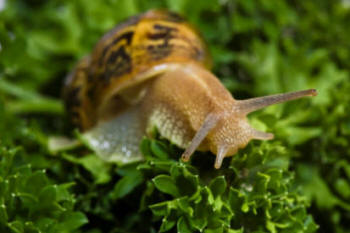
Snails are in many respects the same as slugs as far as gardeners are concerned. The main difference - visually - is the fact that a snail ahs a shell, and therefore tend to do most damage above ground. (It would be rather difficult to drag your house through a small gap to get at an underground tuber!)
However, there is one basic difference between slugs and snails that might be important for gardeners in certain areas. Snails tend to live in areas that are alkaline - Chalk or Lime in the soil, which is used by the snail to make its shell (Not many people know that!)
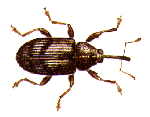
The Strawberry Blossom Weevil - which also attacks Raspberries and Blackberries - has a crafty way of ensuring the success of her young.
Firstly it lays its eggs inside the flower bud, then partially gnaws through the stem below. This ensures that the flower will wilt and eventually drop to the ground where the larvae then lives in the ground - to emerge as an adult the following May-June.
The beetle - weevil - is dark brown to black and just 2 or 3 mm long, with a 'snout' similar to most other weevil beetles.
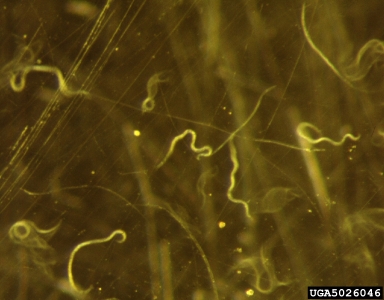
Eelworms are microscopic pest - Nematodes - and not normally seen. In the case of the Strawberry Eelworm there is normally an elongation of the stems and or leaf stalks with red colouring, or may be stumpy short and thick. There is no treatment for eelworm, so dig up the infected plants and burn. Do not compost.
The reddening symptoms should not be confused with a disease of strawberries - Red Core - which is a fungal disease - not a pest.
Any doubt about the symptoms - appearance - should involve the burning off the plant affected, with no further planting in the area for at least 5 years.
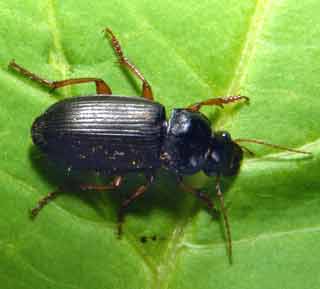
Strawberry Seed beetles cause damage by eating the seeds and also the fruit flesh of ripe and developing strawberries. They are more widespread in the UK than is generally realized, and should be one of the first eliminations in fruit damage investigation – especially if in dry – rather than damp conditions. The damage is mainly on the underside of the fruit.
Whilst it is commonly known as a ‘seed’ beetle, it does in fact gauge considerable chunks out of the ripe fruit. Sometimes the damage is wrongly identified as being caused by birds. This is on account that - on ripe strawberries in particular - it gauges out the flesh which is attached to the seeds. Very often, they damage the fruit from underneath – next to the soil, so are rarely noticed until too late.
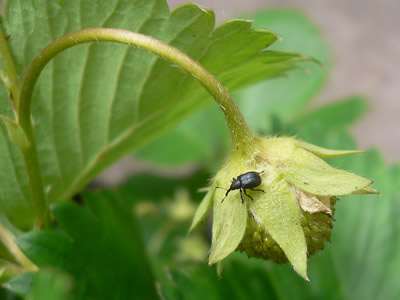
The Strawberry Rhynchites - which also attacks raspberries - and to a lesser degree - blackberries, is a weevil. The adults of which feed on the folded leaves of the strawberry plant in early Spring.
The female wanders off to the flowers where she firstly lays her eggs, then rather craftily punctures the flower stem just below the bud, ensuring that it withers and dies.
It is a serious pest of strawberry crops in UK, and can often be mistaken for blossom weevil. The Strawberry Rhynchites beetle is metallic green whereas the blossom weevil is dull grey/black.
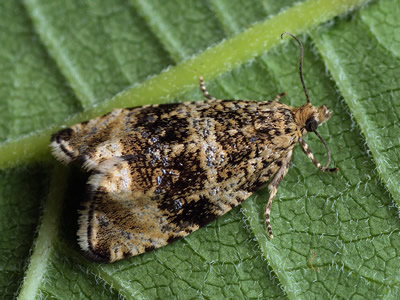
Most damage to strawberry plants by the Tortrix Moth is done to foliage as the caterpillars feed on the young foliage inside a protective web of silk thread spun by the emerging caterpillars as a safe house!
The moth lays its eggs in May and they turn into small caterpillars within a few days. The caterpillars fold the leaves together and then feed on them - eventually falling to the ground in the leaf litter, where it forms a cocoon and overwinters - ready to emerge as a moth early spring.
The Strawberry Tortrix Moth can range in colour from dark brown to bright-ish orange brown.
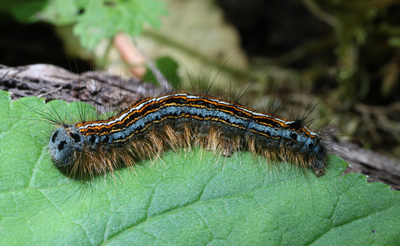
The caterpillar of the Swift Moth lives underground, and feeds on anything it can find there - roots, stems, tubers, bulbs, corms etc.
White caterpillar with brown head, short stumpy front legs. Has a habit of recoiling backwards if disturbed.
The adult swift moth - chunky looking brown moth with white marks on wings, which can be found in May to july, is said not to be able to feed, and therefore only has a lifespan of a few weeks.
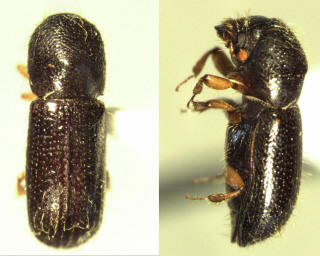
When we talk of boring beetles, we are not referring to general demeanour, but of the nasty habit they have of boring into plant stems to obtain shelter and food! They are grouped together as Bark Beetles’ or Shot Hole Borers’. Bark Beetles are a serious pest as they cause damage - often death - to a wide spectrum of tree types.
Bark Beetles main claim to fame was as a result of the Dutch Elm Disease infestation. This was essentially a fungal disease that was spread from tree to tree rapidly by the Elm Bark Beetle. There are many others which are specific to tree types such as the Ash, Sycamore and Spruce Bark Beetles.
Shot Hole Borers is the generic name, as they leave a trail of small holes in the bark of trees, resulting from their boring into the bark layer in order to get at the soft tissue underneath the cambium layer where they feed and lay their eggs unseen for the most part until the tree limb or the whole tree starts to wilt normally early to mid summer.
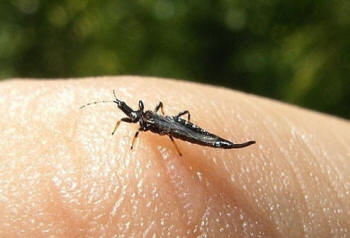
Minute small flies, being less than 2mm in size - Thrips - cause streaky marks on flowers and foliage. They suck the sap out of leaves and flowers, and generally disfigure the plants’ appearance. Both adult flies and the young pupae feed on the plant. Thrips are very small insects - just visible - and are more active in hot dry weather – when the plant is lacking in water.
Thrips are also known as Thunder Flies, for they are very noticeable in or after thundery weather in warm temperatures.
The marks are usually a silvery colour and are pronounced on Gladiolus flowers in particular. With severe infestations of Thrips the leaves can take on a silvery sheen, but can also leave black spots on foliage and flowers alike.
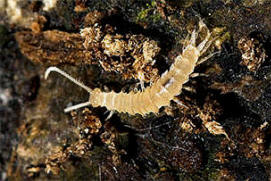
Identification of the Symphylid is quite simple if needed. It is small, normally less than half inch - 1cm - with two long antennae, and twelve pairs of legs. Together with that, it is either white or cream in colour.
Symphylids - Garden Centipedes - eat organic matter, and this includes roots and tubers of plants. Smaller plants can be killed by this destruction.
Symphylids should not be confused with the ordinary Garden Centipede, which is normally orange, and moves quite quickly if disturbed. (It need to be able to move fast, for it lives on insects.
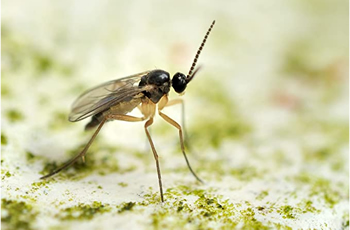
Sciarid Flies are small midge like flies or gnats on composts of houseplants - indoor plants - lay eggs in the compost and the small maggots that emerge are happy to live on the decaying matter of peat based composts, or even attack the small roots of the pot plant. The midges - flies - are often seen flying about near houseplants.
The small grey black fly is just an eighth of an inch long - 2 - 4mm - and is normally seen hopping about on the surface of the compost, or flying around the pot plant. Often referred to as midges.
The maggot feeds just below the surface of the compost, but can sometimes be seen on the surface.